| Botanical Name |
|
| Family |
Verbenaceae - The verbena family. |
| Pronunciation |
|
| Common Name(s) |
IsiXhosa: uTywala bentaka
|
| Plant Group |
- Shrub A woody plant of relatively low height, having several stems arising from the base and lacking a single trunk; a bush.
- Veld Flower Small veld flowers of interest, rather than for their usefulness in the garden. Some of these plants have garden potential, particularly for less formal garden situations.
|
| Plant Size |
- Small
| Tree | 4m to 8m |
| Shrub | 50cm to 75cm |
| Perennial/ground cover | 10cm to 20cm |
| Bulb | 20cm to 30cm |
| Succulent | 10cm to 20cm |
|
| Position |
- Sun The area is in full sun for all or most of the day, all year round.
|
| General Information |
- Attractive fruits, berries or seeds Brightly coloured fruits or berries increase and extend the visual impact of the plant and are especially attractive to birds and other small wildlife.
- Drought Tolerance: High The plant is well adapted to arid conditions; it can survive long periods of drought and high temperatures without extra water.
- Evergreen to semi-deciduous The plant is evergreen in warmer, wetter parts of the country, but may lose some of its leaves during winter in colder, drier situations.
- Frost: Hardy The plant can withstand freezing temperatures or frost without artificial protection.
- Prune hard after flowering Fast growing shrubs that grow lanky within a season. Cut off branches and stems of these plants to a third of their original length. This will increase the yield of flowers, improve the plants shape and enhance the structural strength of main branches.
- Water Wise Plant species originating from low rainfall regions that require less water to survive and thrive than other plant species.
|
| Specific Information |
This is one of about seven lantanas indigenous to South Africa and Africa, and is not an invasive plant. It tolerates arid and coastal conditions. Lantana rugosa is a somewhat sparse shrublet with roughly textured leaves and dainty pink flowers. After flowering, attractive clusters of purple, sweet, edible berries appear. These are usually eaten by children and are a favourite among fruit-eating birds.
|
| Ad Break |
|
| Flowers |
| Description |
The small flowers clustered at ends of stems and look like miniatures of the invasive lantana.
|
| Season |
- Spring to Autumn Plants will seldom bloom for the entire season as given in the list, but should flower during a period within these parameters.
|
| Colour |
|
| Growth Rate |
- Moderate Specifying growth rate can be very misleading as there is considerable variation of growth rate depending on type and species of plant, available water, supplementary feeding, mulching and general care, as well as the plants suitability and adaptability to the garden environment.
|
| Plant Uses |
- Attracts bees, butterflies or other insects This plant attracts insects which can be food for birds or other creatures in your garden.
- Attracts Birds This plant will attract birds.
- Boundary A plant useful for planting around the edges of the property to form a green or colourful backdrop, an impenetrable hedge, to hide walls or create privacy.
- Filler Either a fast growing tree or shrub used temporarily to fill in an area while the permanent plants grow to a desired size, or a plant used to fill gaps in borders or beds.
- Wild Garden An indigenous garden planted for the benefit of wildlife and birds. Provides food, water, a variety of mini-biomes and no poisonous chemicals are used.
|
| Distribution and Habitat |
widely spread throughout South Africa
|
| Planting Suggestions |
Plant in well-drained soil to which some compost has been added and water until the plant has become established. Prune after seeding in winter to encourage bushing.
|
| Medicinal Uses |
Used as a remedy for rheumatism and eye diseases, and to treat bad sores, chest complaints and consumption.
|
| Ad Break |
|


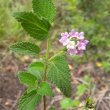
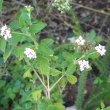
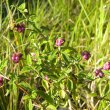
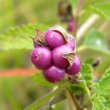
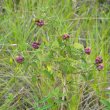




Comments
Indigenous lantana
Hello,
Someone has asked about indigenous lantana on our blog:
http://www.sprig.co.za/2009/02/indigenous-lantana/
They are looking for the Latin name. Also, you describe pink flowers above and we have yellow ones... Are these indigenous too?
Thanks,
Grant
Indigenous lantana
This little shrub is called Lantana rugosa. The yellow lantana you have are most likely alien hybrids as I have never encountered a South African indigenous lantana that is not pink. All seed producing species or seed producing hybrids of Lantana that are non-native to South Africa are listed as Category 1 invaders that must be destroyed. Non-seeding hybrids may be kept and sold.
Difference between Indigenous and Exotic/hybrid
Hi
How would one tell the difference between a purple Lantana rugosa and an exotic purple Lantana spp. Both below one meter, some references say that Lantana rugosa leaves don't smell when crushed.
Ryan Nortier
Lantana rugosa and Lantana camera
Hi Ryan
In order to answer some of your question, I have updated the pictures above, with comments that should help to tell the difference between the two plants. As I have not come across the non-indigenous lantana you mention, I cannot give you a specific comparison. Perhaps you have a picture you could email? I have also copied a post I sent to sprig.co.za last year, onto my blog, with more pictures, in order to provide clarity regarding Lantana in South Africa.
Enquiry about Utywala bentaka
I googled this plant in isiXhosa and see that its botanical name is Lantana....We've recently acquired a farm in the Eastern Cape and had to remove a lot of wattle and acacias there first. There's lots of this beautiful shrub called Utywala bentaka by the locals but they say it's loved by snakes
That's scary for us. Should we remove all of it then?
Discuss this plant
Share knowledge, ask a question or give an experience.